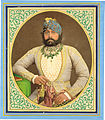File:Portrait of Jaswant Singh II of Jodhpur (1873–1896).jpg

Original file (1,753 × 2,000 pixels, file size: 905 KB, MIME type: image/jpeg)
| This is a file from the Wikimedia Commons. Information from its description page there is shown below. Commons is a freely licensed media file repository. You can help. |
Summary
| DescriptionPortrait of Jaswant Singh II of Jodhpur (1873–1896).jpg |
English: Early portrait photographs in India were frequently hand-colored, blending the mediums of photography and painting. Either the entire photograph was overpainted, or more commonly, features were heightened in color. The portrait, regalia, costume, and jewelry were favored for this treatment. The photographer responsible for this portrayal of Jaswant Singh II of Jodhpur is unknown. However, an inscription beneath the picture names the artist Shivalal, who colored the albumen print with both oil- and water-based pigments.
About the Artist Shivalal and Mohanlal Active at Udaipur, second half of the 19th century; sons of Tara A final phase of painting in Udaipur began under the rulers Sajjan Singh (r. 1874–84) and Fateh Singh (r. 1884–1930) and was influenced by both photography and examples of oil painting. In the ateliers, the brothers Shivalal and Mohanlal, sons of the painter Tara, followed different paths. A work is known that was produced by Shivalal in collaboration with his father in 1858. Shivalal specialized in hunting scenes, most of them created on location, in which the sequence of events is presented dramatically in an expansive landscape. In some of them, Shivalal himself is depicted, and in others, it is probably his brother Mohanlal (functioning as an assistant) who is shown. One of Shivalal’s greatest strengths is the realistic, topographically accurate rendering of hunting reserves and of the landscape around Udaipur. The increasing realism in such depictions also called another medium into play —photography. The rulers of Jaipur and Alwar had already established photographic studios (photokhana) for the purpose of documenting the visits of dignitaries. Shivalal also worked with the new medium, not from behind the camera but rather as a painter, coloring the albumen prints, either with traditional Indian pigments or with oils. While some photographs were completely painted over, on others, only portions were colored, the faces, for example, or the regalia. The medium of photography, with its immediacy and its accuracy, heralded the end of traditional painting. Painters at court were insufficiently prepared for the arrival of photography. Some artists tried to adopt the perspective and compositional schemes of photographs in their pictures, but with limited success. Inevitably, activities at court came to be recorded in the new medium. Even Mohanlal began to capture hunting scenes with a camera, marking the end of traditional picture making in the courts of India. |
| Date |
circa 1875 date QS:P,+1875-00-00T00:00:00Z/9,P1480,Q5727902 |
| Source | https://www.metmuseum.org/Collections/search-the-collections/60050744?rpp=20&pg=2&ao=on&ft=india&pos=25 |
| Author | Photographer unknown, overpainted by Shivalal |
Licensing
|
This is a faithful photographic reproduction of a two-dimensional, public domain work of art. The work of art itself is in the public domain for the following reason:
The official position taken by the Wikimedia Foundation is that "faithful reproductions of two-dimensional public domain works of art are public domain". This photographic reproduction is therefore also considered to be in the public domain in the United States. In other jurisdictions, re-use of this content may be restricted; see Reuse of PD-Art photographs for details. {{PD-Art}} template without license parameter: please specify why the underlying work is public domain in both the source country and the United States
(Usage: {{PD-Art|1=|deathyear=''year of author's death''|country=''source country''}}, where parameter #1 can be PD-old-auto, PD-old-auto-expired, PD-old-auto-1996, PD-old-100 or similar. See Commons:Multi-license copyright tags for more information.) | |||||
File history
Click on a date/time to view the file as it appeared at that time.
| Date/Time | Thumbnail | Dimensions | User | Comment | |
|---|---|---|---|---|---|
| current | 16:29, 18 March 2012 |  | 1,753 × 2,000 (905 KB) | Sridhar1000 |
File usage
Global file usage
The following other wikis use this file:
- Usage on www.wikidata.org
